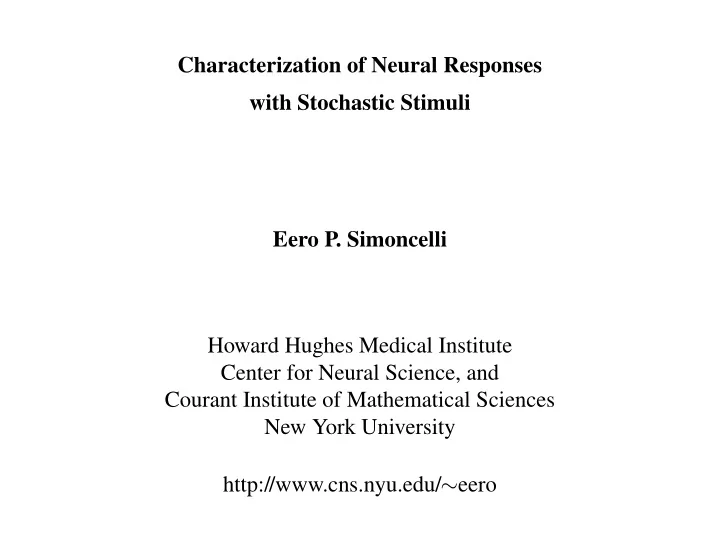

Characterization of Neural Responses with Stochastic Stimuli Eero P. Simoncelli Howard Hughes Medical Institute Center for Neural Science, and Courant Institute of Mathematical Sciences New York University http://www.cns.nyu.edu/ ∼ eero
Neural characterization Ingredients: • stimuli • response model • estimation method
Stochastic stimuli and the spike-triggered ensemble stimulus response t
Stochastic stimuli and the spike-triggered ensemble stimulus component 2 stimulus response t stimulus component 1 6 × 8 stimulus block
Stochastic stimuli and the spike-triggered ensemble stimulus component 2 stimulus response t stimulus component 1
Stochastic stimuli and the spike-triggered ensemble stimulus component 2 stimulus response t stimulus component 1
Stochastic stimuli and the spike-triggered ensemble stimulus component 2 stimulus response t stimulus component 1
Standard V1 models Simple cell Complex cell + Linear → Nonlinear → Poisson (LNP)
Spike-triggered average (STA) stimulus component 2 STA stimulus response t stimulus component 1 Simple LNP characterization: • STA can provide an unbiased estimate of the linear filter • Nonlinearity can be estimated thereafter ... [Chichilnisky, ’01]
Estimating the firing rate nonlinearity # spikes # stimuli # spikes # stimuli firing rate firing rate orthogonal axis response STA response
Failure for symmetric nonlinearity Complex cell model +
Spike-triggered covariance (STC) 2 e1 e1 variance 1.5 e26 1 e26 0 10 20 30 40 eigenvalue number [deRuyter & Bialek, ’88; Schwartz, Chichilnisky & Simoncelli, ’01]
Spike-triggered covariance, complex cell model e1 e1 2 variance 1.5 e2 e26 1 e2 0 10 20 30 40 eigenvalue number
Estimating the (2D) firing rate nonlinearity # stimuli histogram # spikes firing rate e1 response firing rate histogram # stimuli e2 response # spikes
V1 simple cell time STA tf sf space [Rust, Schwartz, Movshon & Simoncelli, CNS*03]
V1 simple cell time STA tf sf space 1.8 1.6 STC 1 variance 0.6 0.2 0 50 100 150 200 250 eigenvalue number [Rust, Schwartz, Movshon & Simoncelli, CNS*03]
V1 complex cell time STA tf space sf 1.8 1.6 STC 1 variance 0.4 0.2 0 50 100 150 200 250 eigenvalue number [Rust, Schwartz, Movshon & Simoncelli, CNS*03]
V1 population statistics # Excitatory eigenvectors # Suppressive eigenvectors 15 15 Simple (n = 15) 5 5 15 15 Complex 5 5 (n = 20) 0 1 2 3 4 5 6 0 1 2 3 4 5 6 = Predictions of standard models
Pairwise firing rate nonlinearities Simple Complex e2 response e1 response � e1 response ST A response e254 response e254 response e255 response e255 response
Excitatory/suppressive pooling model Sum of squares (STA) ? Sum of squares
Simple cell 1.00 0.78 Pooled excitatory signal 0.52 0.78 Sum of squares 0.27 1.00 0.27 Sum 1.00 of Pooled suppressive signal squares Subtractive Divisive
Complex cell 1.00 0.62 0.98 0.67 Pooled excitatory signal 0.75 0.77 Sum of 0.73 squares 0.82 0.58 0.94 Sum 0.58 of Pooled suppressive signal squares 1.00 0.45 Subtractive Divisive
Conclusions • STC characterization with stochastic stimuli can yield a more complete description of neural response • Direction-selective V1 simple/complex cells exhibit multiple excitatory and suppressive components • These components are combined in a simple fashion • To do: – Model validation with optimized stimuli – Modified analysis for non-Poisson spiking models – Application to other areas (retina, V2, V4, MT)
Credits Spike-triggered analyses: Odelia Schwartz, Jonathan Pillow, Liam Paninski Experimental data: V1: Nicole Rust, Tony Movshon (NYU) Retina: Divya Chander, E.J. Chichilnisky (Salk)
Recommend
More recommend